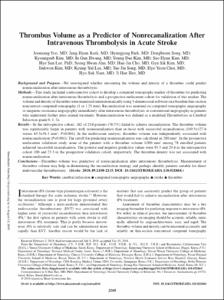Thrombus Volume as a Predictor of Nonrecanalization After Intravenous Thrombolysis in Acute Stroke
- Affiliated Author(s)
- 유준상
- Alternative Author(s)
- Yoo, Joon Sang
- Journal Title
- Stroke
- ISSN
- 1524-4628
- Issued Date
- 2018
- Abstract
- Background and Purpose
We investigated whether measuring the volume and density of a thrombus could predict nonrecanalization after intravenous thrombolysis.
Methods
This study included a retrospective cohort to develop a computed tomography marker of thrombus for predicting nonrecanalization after intravenous thrombolysis and a prospective multicenter cohort for validation of this marker. The volume and density of thrombus were measured semiautomatically using 3-dimensional software on a baseline thin-section noncontrast computed tomography (1 or 1.25 mm). Recanalization was assessed on computed tomography angiography or magnetic resonance angiography immediately after intravenous thrombolysis or conventional angiography in patients who underwent further intra-arterial treatment. Nonrecanalization was defined as a modified Thrombolysis in Cerebral Infarction grade 0, 1, 2a.
Results
In the retrospective cohort, 162 of 214 patients (76.7%) failed to achieve recanalization. The thrombus volume was significantly larger in patients with nonrecanalization than in those with successful recanalization (149.5±127.6 versus 65.3±58.3 mm3; P<0.001). In the multivariate analysis, thrombus volume was independently associated with nonrecanalization (P<0.001). The cutoff for predicting nonrecanalization was calculated as 200 mm3. In the prospective multicenter validation study, none of the patients with a thrombus volume ≥200 mm3 among 78 enrolled patients achieved successful recanalization. The positive and negative predictive values were 95.5 and 29.4 in the retrospective cohort 100 and 23.3 in the prospective validation cohort, respectively. The thrombus density was not associated with nonrecanalization.
Conclusions
Thrombus volume was predictive of nonrecanalization after intravenous thrombolysis. Measurement of thrombus volume may help in determining the recanalization strategy and perhaps identify patients suitable for direct endovascular thrombectomy.
- Department
- Dept. of Neurology (신경과학)
- Publisher
- School of Medicine (의과대학)
- Citation
- Joonsang Yoo et al. (2018). Thrombus Volume as a Predictor of Nonrecanalization After Intravenous Thrombolysis in Acute Stroke. Stroke, 49(9), 2108–2115. doi: 10.1161/STROKEAHA.118.021864
- Type
- Article
- ISSN
- 1524-4628
- Appears in Collections:
- 1. School of Medicine (의과대학) > Dept. of Neurology (신경과학)
- 파일 목록
-
-
Download
 oak-2018-1678.pdf
기타 데이터 / 237.78 kB / Adobe PDF
oak-2018-1678.pdf
기타 데이터 / 237.78 kB / Adobe PDF
-
Items in Repository are protected by copyright, with all rights reserved, unless otherwise indicated.